A Czech national forest park is reviving after a devastating fire
On the first anniversary of the fire in the Bohemian Switzerland National Park, a reporter and photographer from Deník Referendum spent a day there in the company of local experts Dana Vébrová and Jakub Hruška. What they saw contradicts much conventional wisdom.
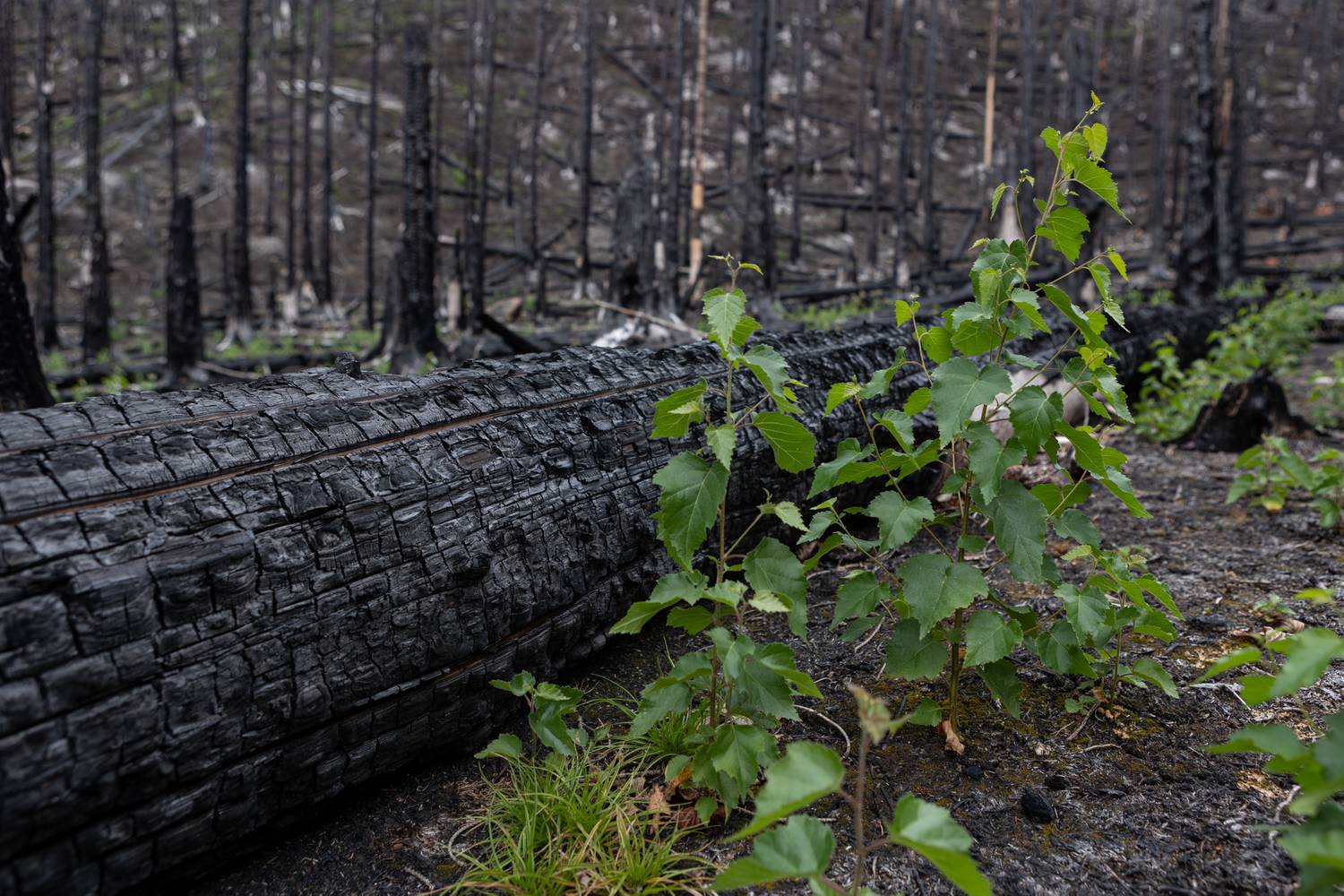
New life is breaking out in the national park. Under the charred trunks of spruce trees, we see carpets of birch trees. Photo by Peter Tkáč, DR
Jakub Hruska’s phone is ringing for the umpteenth time this morning. Journalists are calling him for a comment or an interview about the fire that broke out exactly one year ago in the Bohemian Switzerland National Park. It was this professor of environmental sciences and member of the Czech Republic’s TOP 09 party who, immediately after the disaster, put together a team of scientists to work on a 100-page study for the Czech environment ministry. Their report explains what had caused the fire and allowed it to spread. The fire ravaged one tenth of the national park.
Hruska is also a successful internet influencer. This would soon become apparent during a chance encounter with a national park ranger. “It can’t be Mr Hruska! I love his posts so much!” exclaims the ranger while rushing to shake his hand.
On Facebook, Jakub Hruška talks not only about the fire in the national park and the poisoning of the Bečva River (which he also deals with professionally), but about anything related to politics and ecology. His contributions, which stand out for their clarity and directness, regularly attract engagement from hundreds of ordinary people.
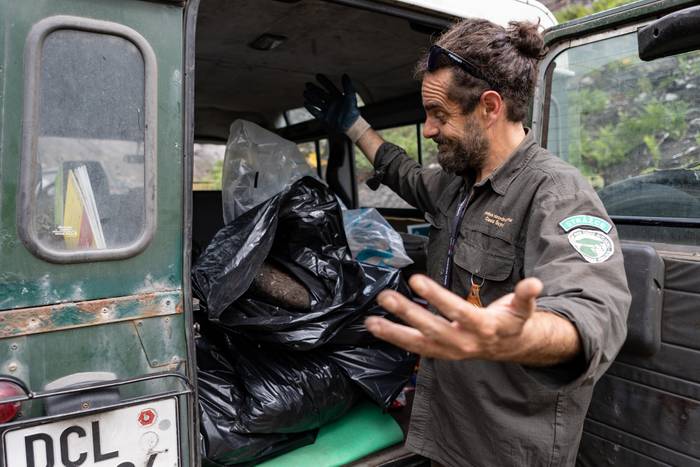
50002
A national park ranger opens the trunk of his car and shows us bags of garbage and construction debris he found in the forest during the day... Photo by Peter Tkáč, DR
“I don’t envy journalists. I imagine how they must write their articles, trying to make them different from the others”, says Dana Vébrová, the head of the National Park Monitoring Department, from behind the wheel of an off-road service car. She does not have to say more for the meaning to be apparent.
The mainstream media has little time, whereas nature has all the time it needs.
The fact that we came on 24th July, the first anniversary of the fire, seems like a carefully orchestrated plan. But in fact it is pure chance, the result of an effort to get the best possible guides.
We want to be initiated into the mysteries of local natural processes. “Well, I’ll never believe that you didn’t arrange it that way on purpose”, Dana Vébrová teases us as she stops the car near the site of the Pravčický mine.
There is no hiking trail through here, and so we spend the next few hours in the arms of nature. The most obvious company is provided by a fruit bat and a couple of screaming jays.
“We are in the driest and hottest part of the national park”, says our guide by way of introduction. She is at home in this landscape, having worked in the national park on and off since 2005.
Holiny is burning
When the park was on fire just a year ago, the public debate was dominated by a popular opinion: if the national park administration had not “stupidly” left standing the dry spruce trees killed by bark beetle, the fire would have been weaker and the firefighters would have had an easier time putting it out amid the complicated rocky terrain.
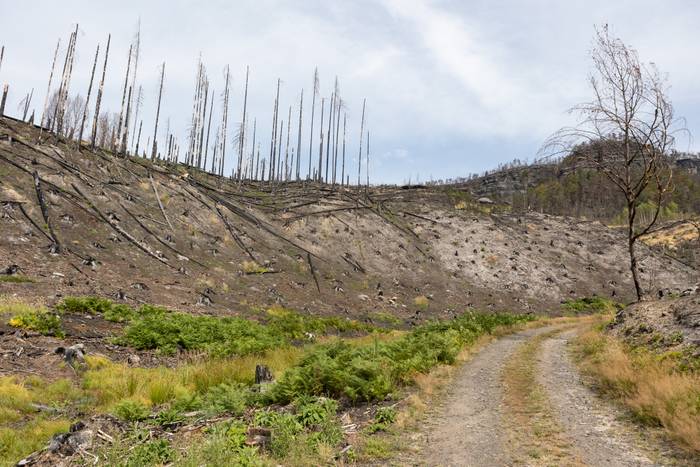
49989
The fire was spreading easily even on the shins. Photo Peter Tkáč, DR
Simply put: armchair experts argued that beetle-infested timber should have been cut down and hauled away. In fact, their ideas contradicted a defining principle of the national park, which is to let natural processes run their course.
Moreover, their layman’s view was wrong. In front of us now is a clearing that not only did not stop the fire, but actually helped it spread further. The tree stumps covering the lower part of the Pravčická mine are completely burnt, as are the blackened stumps further and higher up.
“I wouldn’t make much of a distinction between whether the spruces were standing there or had been taken away”, observes Dana Vébrová. “The important thing is that they were attacked by bark beetles at some point. The spruce then drops a lot of needles and small twigs on the ground. But they stay there, they don’t go anywhere. It’s organic matter that doesn’t go back into the soil”, she explains.
That brush – the loose, dry mixture of pine needles and twigs that is ideal for kindling, as campers know all too well – was added to prolonged drought, heat and high winds. These were the factors that drove last year’s fire. Those spruce trees that had not yet dropped their needles and twigs burned similarly well. They passed the fire through their crowns like torches with the help of the wind.

49990
Many firefighters were out a week after the fire. Today we see thousands of birch trees competing for space with the heather. "These are all ephemeral phenomena. In a year's time, things may be different again", explains Jakub Hruška. Photo by Peter Tkáč, DR
“You can contrast it with a beech forest. There, if you clear away a bit of the ground, you only see a small layer of undecomposed leaves”, she explains. “The soil underneath is absorbent and holds water nicely. Here, it’s exactly the opposite, so when it starts to burn, the fire spreads very easily”.
We will soon see how this works in practice. A few hundred metres to the right of the path, a massive beech tree stands among the charred stumps of spruce trunks. We stare at the spectacular scene in stunned silence. The tree’s crown is green with leaves and round-shaped. It appears as if the fire came nowhere near it. We will see many more beeches like this during the day.
But it was neither a miracle nor the intervention of a ray of higher power that protected these mighty deciduous trees. “We believe it is precisely because there was no layer of dry brush underneath, so that the fire could not reach it easily”, says Vébrová.
Sadly, Vébrová and Jakub Hruska agree that the days of this beautiful giant may nonetheless be numbered. “It will die in a few years, it’s like a zombie tree”, reflects Hruška. Invisibly to the eye, the fire has eroded its bark.
Experts are now waiting anxiously to see if these beeches will still find enough strength to reproduce and help kickstart a new generation of forest. This is the so-called succession. “It could turn out that the beeches can withstand fire better than we imagine”, remarks Vébrová. In a month’s time, the picture should be clearer.
Birch makes its claim
We look out of the car while driving along the asphalt road through the national park from Hřensko to the village of Mezní louka. From a distance it was not entirely clear, but up close we can see that the burnt-out land is now teeming with vegetation.
The ground is densely covered with lush green shoots of birch and rust-coloured cushions of moss. Plants called liverworts also thrive here, particularly a multifloral variety which resembles miniature palm trees. The eagle fern, which resettled the national park just a week after the fire, peeks out in many places. We also see heather and thimbleberries and one mature specimen of mullein. They are thriving because the ash is acting like a fertiliser.
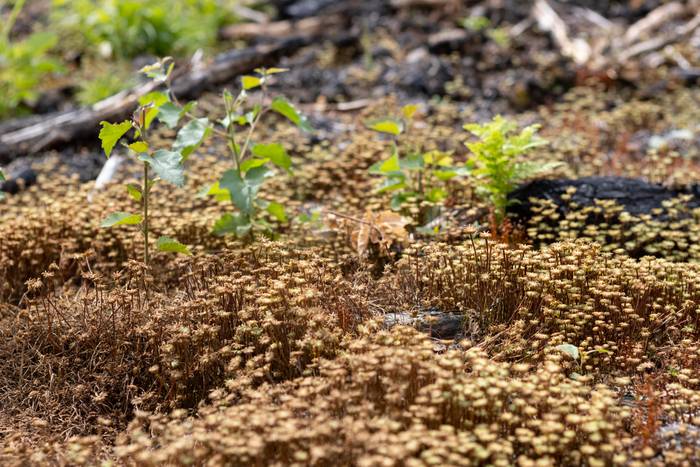
49991
The pioneers of the national park forest regeneration. Photo by Peter Tkáč, DR
“I expected there to be a lot of pine after the fire. Pine is known to be well adapted to fires. But here, the birch has emerged as the champion in fire adaptation. It is absolutely unrivalled, it can withstand a lot of fire and just keep growing. It also spreads quickly and occupies bare areas everywhere”, says Dana Vébrová, visibly pleased.
The clearing where we are standing was completely black after the fire. Since then the ash was gradually washed away. Some got into the soil, where it served as fertiliser. But above all, the fire removed the layer that prevented succession – in simple terms, the emergence of new life. The fire disturbed a part of the terrain where pioneer trees had been unable to take hold. Today, in addition to the birch, there are also aspen, willow and cranesbill.
“Pioneer trees are specific in that they have a tiny seed. And the smaller the seed is, the shorter time it can lie dormant. It also doesn’t have the strength to grow through a layer of spruce undergrowth. Pioneers therefore need the soil to be disturbed in some way. In addition to fire, uprooted logs help them do this by exposing the soil beneath the roots. The advantage of pioneers, on the other hand, is that they can cope with climatic extremes, so they thrive even here in the clearing, where it can be very hot and dry. Beech trees, for example, need shade and a more clement microclimate”, Dana Vébrová takes us deep into the dramatic vicissitudes of the life of tree seeds.
What we take away from this is that pioneer species generally do poorly in spruce groves. The stumps there do not turn over, and the undergrowth does not decompose.
Seed bank
Colonisation is not the only source of new vegetation. The other is the so-called seed bank – a supply of living seeds stored in the soil. Many of these are in a so-called dormant state, i.e. they are dormant and their physiological processes are suspended until the stimulus comes to start them. And that stimulus was the fire.
“The researchers tried putting the burnt soil from here into a greenhouse, where they look after it and see what comes out of it”, explains Vébrová. “It turned out that the seed bank was not as affected by the fire as we had feared. Even a few centimetres below the soil surface, temperatures are already low. So now the researchers are seeing birch, aspen, heather, grasses and all sorts of herbs growing out of it”. Her tone is hopeful as she deftly leads us down a steep forest path from the clearing towards a rock plateau.
“Here I see a spruce seedling!” shouts Jakub Hruška from the burnt-out clearing. “Shall we pluck it?” Dana Vébrová asks absently.
At the foot of this rock massif, the burnt area turns into a living forest. Perhaps because it is hidden in the rocks, it had a wetter surface and the fire did not penetrate sufficiently. There is even a small patch of wetland here, which must have played its part as well.
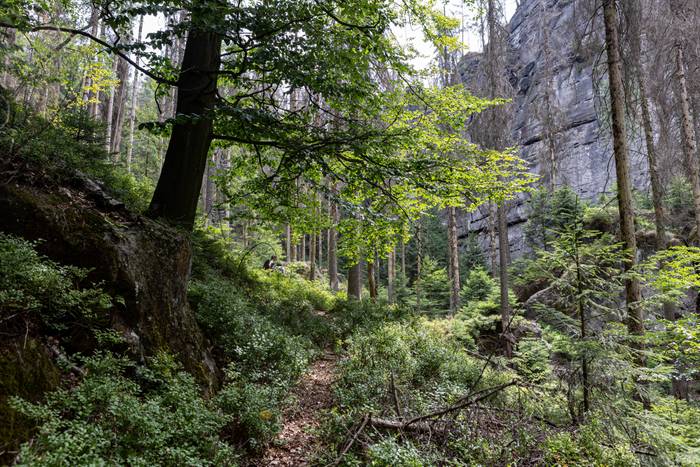
49995
The forest at the base of the rocks escaped the fire not because of the firefighters, but probably because it has a wetter ridge. It was also protected by a small wetland. Photo by Peter Tkáč, DR
“The fire spreads best uphill, as the flames rise”, Vébrová explains. “But because the landscape here is so rugged – a plateau at the top and a ravine behind it, the fire sometimes spreads by gravity. Something was burning at the top, it started to fall, and so the fire spread both from below and above”.
When we finally arrive on the rocky plateau, we not only have a view of the vast burn area, but also of an approaching storm. What would they have given for this here a year ago… But our guides are nervous. Dana Vébrová explains that this is not so much because of potential lightning as for the rising wind, which can easily uproot the charred pine trees standing around. The trees have burnt roots, so they have lost their firm anchorage in the ground.
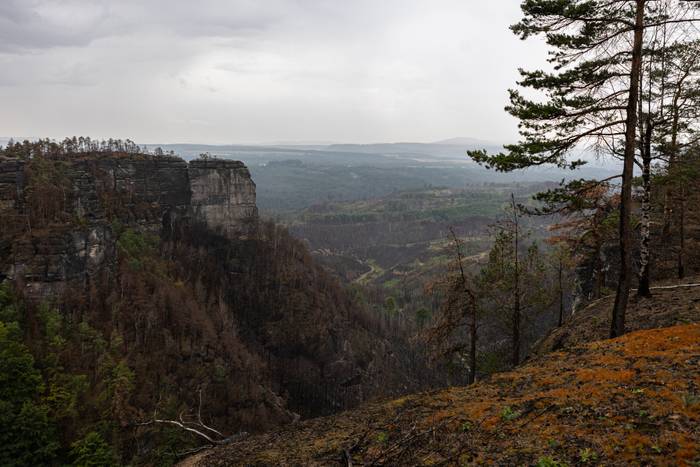
49997
The spectacular sandstone formations are the reason why this was declared a national park in 2000. The view from the plateau shows the extent of the fire. Photo by Peter Tkáč, DR
Our guide quickly checks the weather radar on her mobile phone and then escorts us from the plateau to the nearest gully. Her quick pace convinces us that she is serious about the danger. The rain starts to fall, and from under the shelter of a large beech tree we watch the wind on the plateau lash the sad remains of the former pine grove. The damp landscape smells of a year-old burn. Fortunately, the lightning does not come near.
Tourism versus nature
The rain and wind continue but do not keep us pinned in the gully for long. As soon as they ease off a bit, we get moving again along the path back to the car.
Dana Vébrová wants to show us one more place. As an illustration of the clash between the desires of tourists and the demands of nature conservation – the reason for Czechia’s national parks – nothing could be more eloquent.
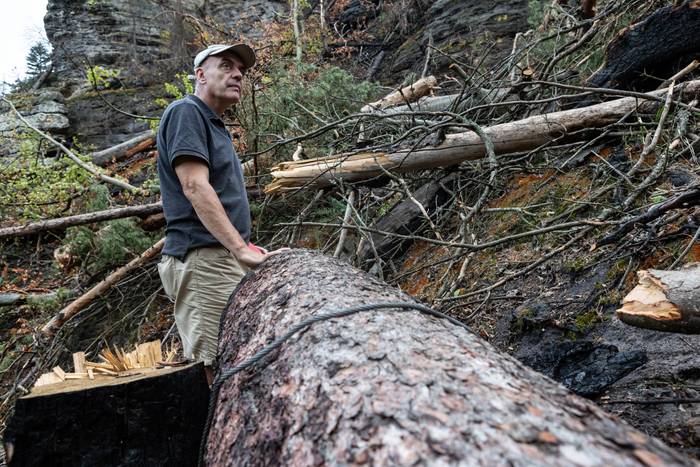
50000
Safety logging, a source of much embarrassment. Photo by Peter Tkáč, DR
Edmund’s Gorge is connected to the village of Hřensko. As a beautiful rocky canyon through which the Kamenice River flows, it is a popular destination for hikers. Also on offer are guided boat trips, run by the municipality.
“Unfortunately, there was a rather intense fire in Edmund’s Gorge as well”, our guide tells us as we drive. And, as we just learned on the rocky plateau, trees with charred roots are no laughing matter. Currently, dead logs are threatening to fall on the hikers at the bottom of the gorge, along with loose rocks. “But we are being asked to let the tourists back in as soon as possible. At first the municipality didn’t believe us about how big the risk is”, says Vébrová laconically.
The director of the national park decided to launch a pilot project. The dead trees and loose stones would be cleared from the rocky promontory atop the gorge, just above the site of the ticket office and boat ramp. It would be seen whether the risk can be eliminated. “There’s been a bunch of guys working there for a few weeks now. They’ve been chopping down the dead trees, moving them with the help of motorised winches. They’re shifting or stabilising the stones, and anchoring the trees with steel cables”, says Dana Vébrová. She wants to show us.
Listening to it, it sounds like a building site. This might seem awkward for a Natura 2000 site, an area under EU protection. There is even a question as to whether Czechia is breaking the law in its efforts to make the site accessible to tourists.
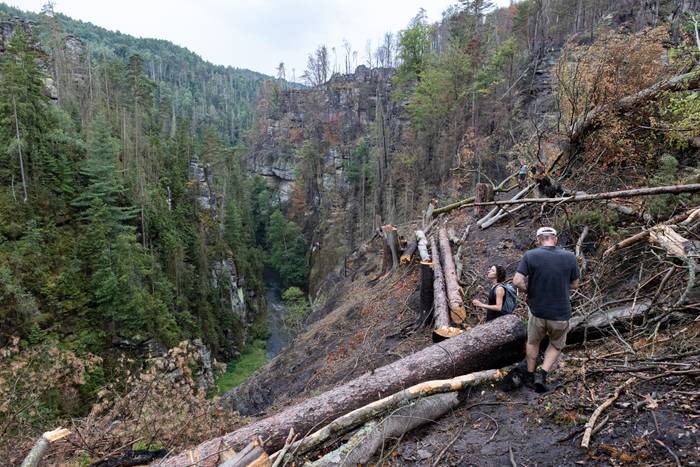
49999
Doubts arise whether tourists who want to return to Edmund's Gorge soon would appreciate such an intervention. Photo by Peter Tkáč, DR
But when we arrive there and finally have the opportunity to see it, the reality seems worse still. What is being done in the name of safety – and, more importantly, to protect a tourist attraction – not only appears to be a gross violation of nature, it also looks anything but safe.
“It is as if we cannot say whether we can eliminate the risk. And that it’s more up to the operator, in our opinion, to let these people in and take the risk”, says Dana Vébrová cautiously.
It is clear that she is treading carefully around a sensitive topic. “But I am mainly sorry that we are intervening in a natural process. For example, the juvenile beech trees here, which the guys ripped apart when handling the removed logs”. She talks with the unmistakable sadness of a person who has the national park’s interests at heart. Jakub Hruška’s comment is apt: “Such are the times today. Everybody would like to visit a wilderness gorge, but only in absolute safety”.
The blame
Last summer was 2.7 degrees Celsius warmer in the Ústí nad Labem region than the average of the years 1961-2000. It was the sixth hottest summer in Czechia since 1961. According to scientists who prepared the study for the environment ministry, the high temperatures made it easy for the fire to spread, and difficult to extinguish. The report says: “With high temperatures, the effectiveness of firefighting with water was reduced, so repeated interventions were necessary”.
The national park recorded 22 days of no rainfall at all during the summer. Very low totals came at the turn of the holiday months and in mid-August. However, the first major rain – almost 25 millimetres in total – did not fall until 20 August. This also helped to put out the fire.
So three main factors are to blame for the fire. Firstly: the arsonist who started it in the first place. In fact, few people here believe it was the man who confessed to the fire. He is said to have started several smaller fires in the past, but the main one was perhaps claimed in a bid for attention.
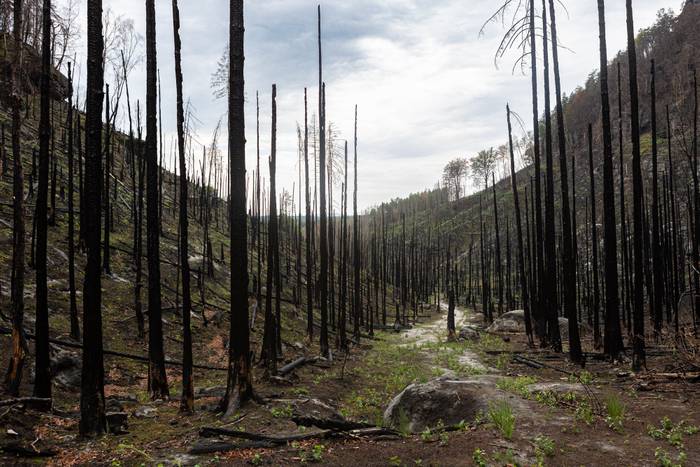
49998
In the years before the fire, the local spruce forest was living up to its name. It was clear that something was going to happen. Photo Peter Tkáč, DR
The second factor is the context of rapidly unfolding climate change. And the third is the way the local forests have been managed over the past century. In short: coniferous trees were introduced here by our ancestors for economic reasons, because they grow well. And today we are reaping the fruits of their short-sightedness.
“The original type of forest was used by our ancestors for construction timber, for glassworks, for industry. For a while, the way it worked was to let the forest regenerate spontaneously. They were not able to harvest the amount of timber that we do, and so they did not practise clear-cutting. So the forest always had something to regenerate from. But as technology developed, larger areas have been deforested”, says our guide.
Because they needed the harvested wood to grow back quickly, they planted spruce: “At that time they were lucky, the climate was still milder and colder. The spruce grew very well here until the turn of the nineteenth and twentieth centuries”.
In 1920 came the so-called beetle calamity. In forests all over the country, the bark beetle multiplied and spruce forests died. “Unfortunately, foresters’ memories are terribly short”, sighs Dana Vébrová. “Perhaps because a person does not experience the entire cycle of a forest in his or her lifetime, foresters did not pass on their knowledge, and after the beetle calamity they replanted the area with spruce”.
In 2000, the Bohemian Switzerland National Park was created. Not in the name of its important forests, but rather for its fantastic sandstone cliffs, the largest in Central Europe. At that time, the local forests were just reaching the stage when they would require management. Their lifespan is around a hundred years, which is roughly how long it has been since the bark-beetle calamity.
“We knew that the only way to try to prevent a complete collapse was to thin the spruce as much as possible, so as to get other tree species in”, says Dana Vébrová. “Either plant them or let them colonise. But people don’t feel good about logging in a national park. We’ve been criticised for that. We’d been doing it like this for 15 years, and then the drought came. Then there was nothing we could do. What we feared became reality”.
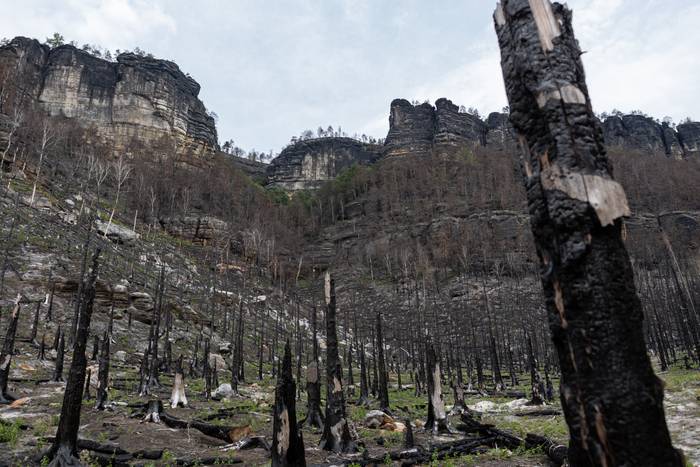
49992
According to Jakub Hruška, the rocks have always met fires here and are used to them. Photo by Peter Tkáč, DR
“We always told ourselves that once it happened, it would be big. But it was even bigger than we imagined. We knew from the textbooks about the bark-beetle calamity and some other minor beetle episodes. But that a beetle would take down the whole place like that…” Dana Vébrová’s story brings us back to one of her initial remarks: a forest infested with bark beetle, and on dry sandstone, burns very well, whether it is logged or not.
Respecting fire
If anything could have been done differently to lessen the impact of last year’s fire, it was not the responsibility of the national park’s administrators. It was up to the people who managed the area long before the park was established. At the end of the excursion, we ask our guides the obvious question about how the national park intends to deal with fires in future years. We know that climate change will only complicate the situation.
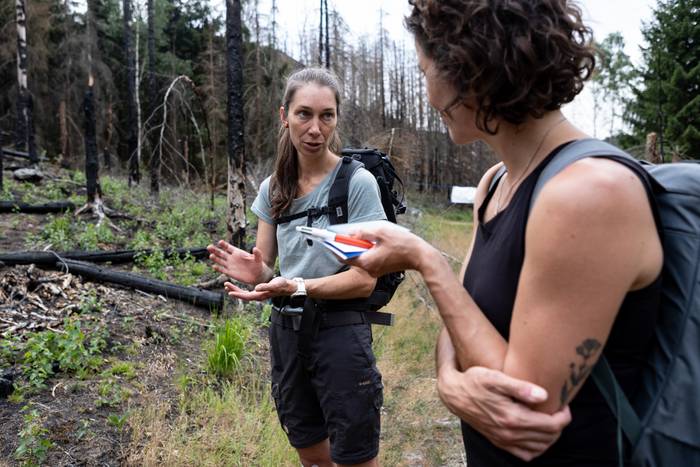
50001
Dana Vébrová has been working in the National Park since 2005. She has a very engaging way of telling the story of how nature works here without the help of the human hand. Photo Peter Tkáč, DR
“But national parks are not there to provide fire protection. They are there to allow natural processes to unfold undisturbed. And to look after biodiversity. For us, even if it’s lit by an arsonist, fire is a natural agent in its impact. We respect that. We have a process going on here that is heavily influenced by fire. Nothing is amiss. Fire belongs here”, says Dana Vébrová. “Exactly”, confirms Jakub Hruška.
Original source: https://denikreferendum.cz/clanek/35465-lesni-obrozeni-narodniho-parku
 This material is published in the context of the "FIRE-RES" project co-funded by the European Union (EU). The EU is in no way responsible for the information or views expressed within the framework of the project. Responsibility for the content lies solely with EDJNet. Go to the FIRE-RES page
This material is published in the context of the "FIRE-RES" project co-funded by the European Union (EU). The EU is in no way responsible for the information or views expressed within the framework of the project. Responsibility for the content lies solely with EDJNet. Go to the FIRE-RES page
